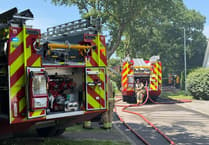DAVID List is general manager of the Tamar Bridge and Torpoint Ferry Company, a role where he says nothing is ever routine and there is no such thing as an average day.
Asked what are the main challenges of his position, he said maintenance is the major engineering challenge.
When the bridge was built it had an estimated lifespan of 120 years, so now that we have reached 60 years of its lifespan that represents a major milestone.
A display board in the Bridging the Tamar heritage centre notes that in 1961 there was an average of 4,000 vehicles a day using the bridge – but by 2018 that total had reached 38,200 on an average weekday.
Mr List said the bridge is unusual – and unique in the UK – in that it has a three-lane main deck, with the lane management indicators allowing them to switch which lanes are open in which direction.
There is also a very high traffic load with an almost tidal flow – traffic is heaviest towards the east in the morning, and then heaviest towards the west in the evening, so the switching of which lanes are open in each direction at peak times is needed to keep traffic flowing smoothly.
The bridge and ferry have to cover their costs – and this could become difficult at a time when both central and local government policies are to reduce use of private transport and steer people towards more sustainable options like cycling or public transport.
I asked what a typical working day was like for him – and he said there was never a typical average working day as every day threw up its own matters and challenges to deal with, and of course that included operation of the Torpoint Ferry as well as the Tamar Bridge.
One current problem is the road studs, with signs on the approach to the bridge warning drivers to be aware of the issue and to obey gantry signs.
Mr List said a fault had developed but that they hoped to have it sorted out by mid-November.
He explained that the system used slots cut in the roadway into which nodes were inserted, and then the road studs fitted into those nodes without any need for their own electrical connectors.
Mr List said he wasn’t able to comment on the question of whether the bridge should be subsidised and whether tolls would continue – he said that was a question for the politicians.
However, he added that the Tamar Crossings company pioneered electronic tolls in 2007 and there have been many changes over time – when he first started with the company, people were still using paper discount tickets whereas now 60% of regular bridge users use the Tamar tags. This relies on customers having an account with the crossings company.
But nowadays other bridges have switched to open road tolling by making use of number-plate recognition cameras – the Dartford Crossings linking both side of the Thames in East London are an example – but that isn’t totally straightforward.
The challenge with such a method as regards the Tamar Bridge is that the operators vary which lanes are open to ensure smooth flow, and also there is a roundabout junction at the east end of the bridge which would present challenges to using such a system.
Another problem is chasing up any toll violators – Mr List said you need tens of staff to chase up those who don’t pay, but the Tamar Bridge may move towards such a system in time.
He said the fact that he was commenting on it showed that some consideration was being given to the matter.




